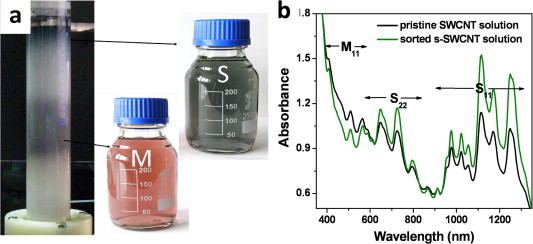文章专利

- 地址: 江苏省苏州市苏州工业园区若水路398号
- 邮箱: tzhang2009@sinano.ac.cn
- 电话: 86-512-62872706
- 传真: 0512-62603079
- 网址: http://nanosensor.sinano.ac.cn

Hongbo Li, Jing Zhang, Guanghui Li, Fufui Tan, Rui Liu, Ru Li, Ting Zhang, Hehua Jin, and Qingwen Li*. Triton assisted fabrication of uniform semiconducting single-walled carbon nanotube networks for highly sensitive gas sensors. Carbon, 2014, 66, 369-376.
Abstract
Surfactants are vital for the dispersion and separation of single-walled carbon nanotubes (SWCNTs) when using chromatographic methods. However, excessive surfactant impurities left on the sorted tube surface and in solution may dramatically affect the fabrication and performance of various SWCNT-based thin-film devices. We demonstrated that compared to the widely used anionic surfactants, including sodium dodecyl sulfate, sodium dodecyl benzene sulfonate and sodium deoxycholate, the nonionic Triton surfactant was more effective not only for the enrichment of semiconducting (s-) SWCNTs, but also for preventing the tubes from severe aggregation upon network formation. Simply by spreading and rinsing treatment, a clean and homogenous network of s-SWCNTs was favorably formed between electrode channels, in which intertube contacts or junctions were well built up. The resultant sensor device showed an obviously improved electrical response to H2S with the detection level down to 50 ppb even at room temperature, compared to those fabricated from the pristine SWCNTs and s-SWCNTs eluted with anionic surfactants. Our work provides an easy route for the sorting and application of s-SWCNTs at a low cost.
Full Article:http://www.sciencedirect.com/science/article/pii/S0008622313008518

